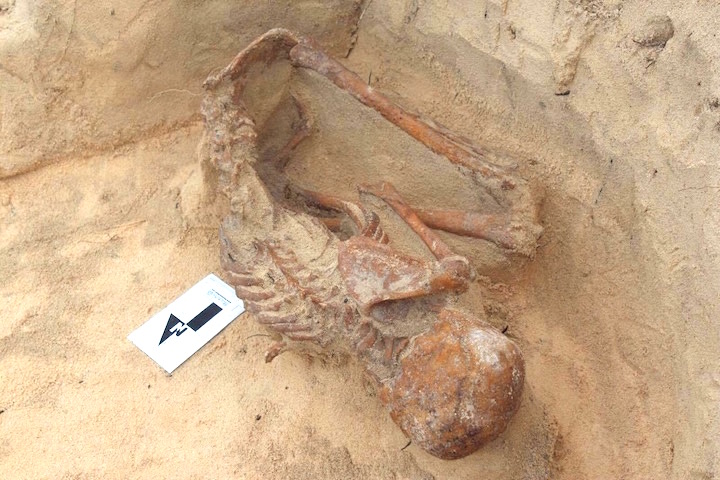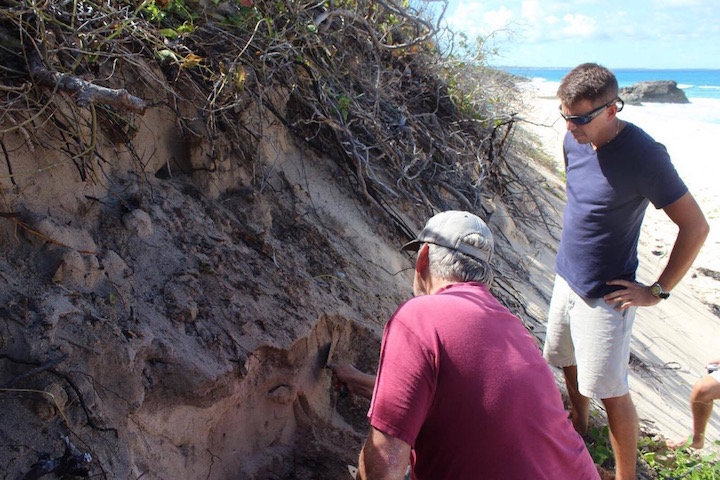From:TheBahamasWeekly.com
Ancient Lucayan Skeletons Discovered in Clarence Town, Long Island
By Shonalee Johnson
Nov 15, 2016 - 9:08:02 PM

Remains found in Lucayan burial site near Clarence Town, Long Island
|
AMMC In Partnership With Florida Museum of Natural History To Excavate Three Burials Near Beach in Long Island
Nassau, Bahamas — Officials from the Antiquities, Monuments & Museum Corporation (AMMC) today announced the discovery of ancient skeleton remains in Clarence Town, Long Island. The bones, located in two distinct graves, appear to be that of Lucayan people who inhabited the archipelago from 600 AD to the 1500’s.
Long Island resident Nick Constantakis found the first set of bones of what appears to be the remains of an elderly Lucayan male, buried face down in the sand dunes near Clarence Town. Another discovery by Nick and Anthony Maillis of Clarence Town revealed a second burial approximately 25 feet away from where the original bones were located. Local residents, in turn, reached out to Dr. Keith Tinker, Director of AMMC once the bones were determined to be of historical significance.
Last month, a team from AMMC and the Florida Museum of Natural History travelled to Long Island to conduct preliminary excavation exercises. Under the existing memorandum between the two entities, the Florida-based museum is committed to fully support the AMMC with research of historical discoveries. The second burial held the remains of a Lucayan female, buried face down. The excavation team indicated that the remains appear to be an elderly female at the time of her death. Directly under the second burial, the team also uncovered a third set of remains in a bundle with limbs removed of what could possibly be the bones of ayoungerfemalerelative of the older female found in the burial site.
According to Dr. Michael Pateman, Assistant Director at AMMC, the recent finds are significant to understanding Bahamian prehistory. “This is the first time we have ever excavated multiple Lucayan burials on a beach dune. Previously, all burials found in The Bahamas have either been in caves or discovered in blue holes,” Dr. Pateman explained. “From our preliminary investigations, we were able to discern that these are the remains of Lucayans because the skulls all have cranial flattening, which was a common practice to flattened both the front and back of their heads.”

Dr. William Keegan (left) and Anthony Maillis (right) excavate burial site to preserve remains of ancient Lucayan bones found in the sand dunes near beaches in Clarence Town, Long Island.
|
He continued: “These recent discoveries will allow us to further examine the lifestyle, diet, occupations and overall way of life of this group of people. We will also be able to examine specific burial practices and aspects of their spirituality. It is our intention to return to Long Island to conduct a larger survey project in December 2016.”
The project is supported by AMMC, through a partnership with the Florida Museum of Natural History. Dr. William Keegan, lead archaeologist on the Florida team, said the goal of the first phase of the project is to define the prehistoric landscape of the area.
“We need to understand where and when people were using the area in relation to the burials. We will also try to identify additional burials. A long-standing question is where the prehistoric inhabitants of The Bahamas, called Lucayans, buried their dead. There are a few burials known from caves and sinkholes, but they are too few to account for all of the people who lived and died over the approximately 1000 years The Bahamas was occupied,” Dr. Keegan said.
“A couple of possible dune burials have been reported, but this is the first location to be professionally excavated. If there are more burials in this area, then this would be the first prehistoric cemetery in all of The Bahamas.”
Archeologists have discovered more duhos (wooden ceremonial stools) in The Bahamas than in any other Caribbean country with the majority of those discoveries occurring in Long Island. Determined to let the “bones tell the story”, on completion of the studies, the team will publish findings and eventually set up a full exhibit at the Long Island Museum to tell the full story of the islands connection to the Lucayan people.
Based on the second round of excavations, if additional burial sites are found, the team will work to secure additional grants and funding for expanded research. The Corporation encourages members of the general public to notify AMMC officials should they suspect they have uncovered ancient artifacts or potential burial tombs so that sites can be properly excavated to preserve the integrity of the items discovered.
Island law enforcement officers were notified of the discoveries.
© Copyright 2016 by thebahamasweekly.com -

